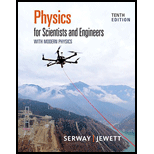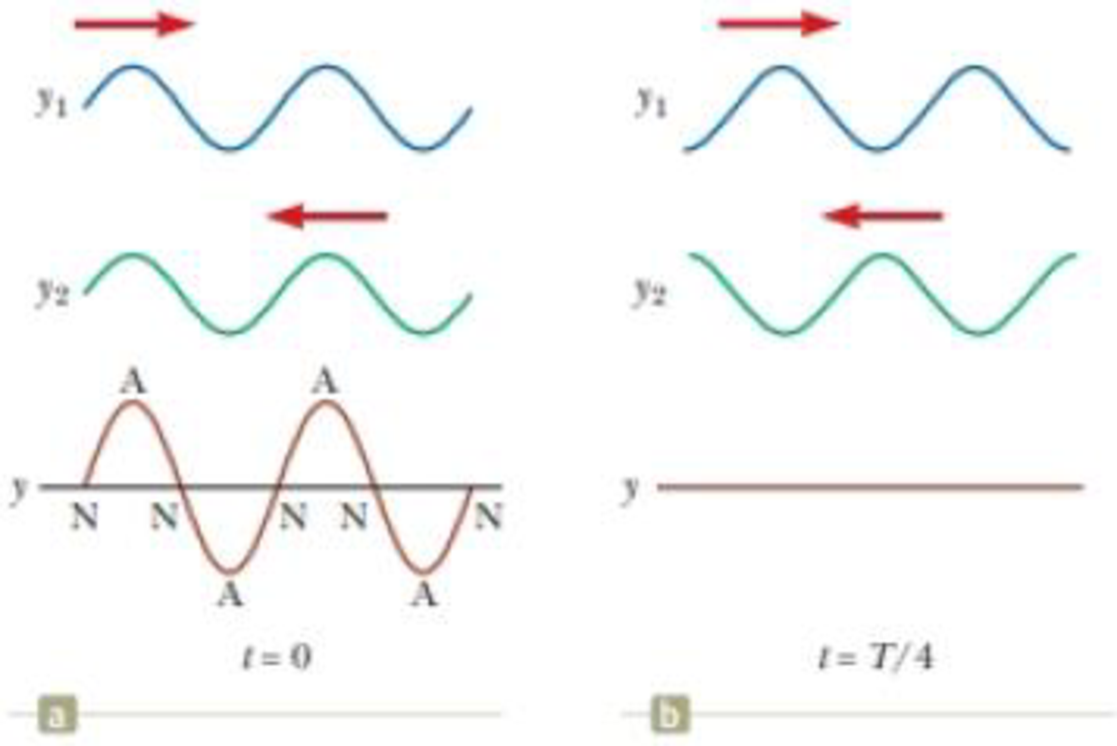
Physics for Scientists and Engineers with Modern Physics
10th Edition
ISBN: 9781337553292
Author: Raymond A. Serway, John W. Jewett
Publisher: Cengage Learning
expand_more
expand_more
format_list_bulleted
Concept explainers
Textbook Question
Chapter 17.2, Problem 17.2QQ
Consider the waves in Figure 17.8 to be waves on a stretched string. Define the velocity of elements of the string as positive if they are moving upward in the figure. (i) At the moment the string has the shape shown by the red-brown curve in Figure 17.8a, what is the instantaneous velocity of elements along the string? (a) zero for all elements (b) positive for all elements (c) negative for all elements (d) varies with the position of the element (ii) From the same choices, at the moment the string has the shape shown by the red-brown curve in Figure 17.8b, what is the instantaneous velocity of elements along the string?

Expert Solution & Answer
Trending nowThis is a popular solution!

Students have asked these similar questions
2
3
Imagine you are out for a stroll on a sunny day when you encounter a lake. Unpolarized light from the sun is reflected off the lake into your eyes. However, you notice when you put on your vertically polarized sunglasses, the light reflected off the lake no longer reaches your eyes. What is the angle between the unpolarized light and the surface of the water, in degrees, measured from the horizontal? You may assume the index of refraction of air is nair=1 and the index of refraction of water is nwater=1.33 . Round your answer to three significant figures. Just enter the number, nothing else.
Chapter 17 Solutions
Physics for Scientists and Engineers with Modern Physics
Ch. 17.1 - Prob. 17.1QQCh. 17.2 - Consider the waves in Figure 17.8 to be waves on a...Ch. 17.4 - When a standing wave is set up on a string fixed...Ch. 17.6 - Prob. 17.4QQCh. 17.6 - Prob. 17.5QQCh. 17 - Two waves on one string are described by the wave...Ch. 17 - Two pulses of different amplitudes approach each...Ch. 17 - Two wave pulses A and B are moving in opposite...Ch. 17 - Why is the following situation impossible? Two...Ch. 17 - Two pulses traveling on the same string are...
Ch. 17 - Two identical loudspeakers 10.0 m apart are driven...Ch. 17 - Two sinusoidal waves on a string are defined by...Ch. 17 - Prob. 8PCh. 17 - Prob. 9PCh. 17 - Prob. 10PCh. 17 - Prob. 11PCh. 17 - Prob. 12PCh. 17 - A string that is 30.0 cm long and has a mass per...Ch. 17 - Prob. 14PCh. 17 - Review. A sphere of mass M = 1.00 kg is supported...Ch. 17 - Prob. 16PCh. 17 - Prob. 17PCh. 17 - Prob. 18PCh. 17 - Prob. 19PCh. 17 - Prob. 20PCh. 17 - The fundamental frequency of an open organ pipe...Ch. 17 - Ever since seeing Figure 16.22 in the previous...Ch. 17 - An air column in a glass tube is open at one end...Ch. 17 - Prob. 24PCh. 17 - Prob. 25PCh. 17 - Prob. 26PCh. 17 - As shown in Figure P17.27, water is pumped into a...Ch. 17 - As shown in Figure P17.27, water is pumped into a...Ch. 17 - Prob. 29PCh. 17 - Prob. 30PCh. 17 - Prob. 31PCh. 17 - Prob. 32PCh. 17 - Prob. 33PCh. 17 - Prob. 34APCh. 17 - Prob. 35APCh. 17 - A 2.00-m-long wire having a mass of 0.100 kg is...Ch. 17 - Prob. 37APCh. 17 - Prob. 38APCh. 17 - Prob. 39APCh. 17 - Review. For the arrangement shown in Figure...Ch. 17 - Prob. 41APCh. 17 - Two speakers are driven by the same oscillator of...Ch. 17 - Prob. 43APCh. 17 - Prob. 44APCh. 17 - Prob. 45APCh. 17 - Prob. 46APCh. 17 - Review. A 12.0-kg object hangs in equilibrium from...Ch. 17 - Review. An object of mass m hangs in equilibrium...Ch. 17 - Prob. 49APCh. 17 - Prob. 50CP
Knowledge Booster
Learn more about
Need a deep-dive on the concept behind this application? Look no further. Learn more about this topic, physics and related others by exploring similar questions and additional content below.Similar questions
- 20. Two small conducting spheres are placed on top of insulating pads. The 3.7 × 10-10 C sphere is fixed whie the 3.0 × 107 C sphere, initially at rest, is free to move. The mass of each sphere is 0.09 kg. If the spheres are initially 0.10 m apart, how fast will the sphere be moving when they are 1.5 m apart?arrow_forwardpls help on allarrow_forwardpls help on thesearrow_forward
- pls help on all asked questions kindlyarrow_forwardpls help on all asked questions kindlyarrow_forward19. Mount Everest, Earth's highest mountain above sea level, has a peak of 8849 m above sea level. Assume that sea level defines the height of Earth's surface. (re = 6.38 × 106 m, ME = 5.98 × 1024 kg, G = 6.67 × 10 -11 Nm²/kg²) a. Calculate the strength of Earth's gravitational field at a point at the peak of Mount Everest. b. What is the ratio of the strength of Earth's gravitational field at a point 644416m below the surface of the Earth to a point at the top of Mount Everest? C. A tourist watching the sunrise on top of Mount Everest observes a satellite orbiting Earth at an altitude 3580 km above his position. Determine the speed of the satellite.arrow_forward
- pls help on allarrow_forwardpls help on allarrow_forward6. As the distance between two charges decreases, the magnitude of the electric potential energy of the two-charge system: a) Always increases b) Always decreases c) Increases if the charges have the same sign, decreases if they have the opposite signs d) Increases if the charges have the opposite sign, decreases if they have the same sign 7. To analyze the motion of an elastic collision between two charged particles we use conservation of & a) Energy, Velocity b) Momentum, Force c) Mass, Momentum d) Energy, Momentum e) Kinetic Energy, Potential Energyarrow_forward
arrow_back_ios
SEE MORE QUESTIONS
arrow_forward_ios
Recommended textbooks for you
 Physics for Scientists and Engineers: Foundations...PhysicsISBN:9781133939146Author:Katz, Debora M.Publisher:Cengage Learning
Physics for Scientists and Engineers: Foundations...PhysicsISBN:9781133939146Author:Katz, Debora M.Publisher:Cengage Learning University Physics Volume 1PhysicsISBN:9781938168277Author:William Moebs, Samuel J. Ling, Jeff SannyPublisher:OpenStax - Rice University
University Physics Volume 1PhysicsISBN:9781938168277Author:William Moebs, Samuel J. Ling, Jeff SannyPublisher:OpenStax - Rice University Principles of Physics: A Calculus-Based TextPhysicsISBN:9781133104261Author:Raymond A. Serway, John W. JewettPublisher:Cengage Learning
Principles of Physics: A Calculus-Based TextPhysicsISBN:9781133104261Author:Raymond A. Serway, John W. JewettPublisher:Cengage Learning Physics for Scientists and Engineers, Technology ...PhysicsISBN:9781305116399Author:Raymond A. Serway, John W. JewettPublisher:Cengage Learning
Physics for Scientists and Engineers, Technology ...PhysicsISBN:9781305116399Author:Raymond A. Serway, John W. JewettPublisher:Cengage Learning Physics for Scientists and Engineers with Modern ...PhysicsISBN:9781337553292Author:Raymond A. Serway, John W. JewettPublisher:Cengage Learning
Physics for Scientists and Engineers with Modern ...PhysicsISBN:9781337553292Author:Raymond A. Serway, John W. JewettPublisher:Cengage Learning Physics for Scientists and EngineersPhysicsISBN:9781337553278Author:Raymond A. Serway, John W. JewettPublisher:Cengage Learning
Physics for Scientists and EngineersPhysicsISBN:9781337553278Author:Raymond A. Serway, John W. JewettPublisher:Cengage Learning

Physics for Scientists and Engineers: Foundations...
Physics
ISBN:9781133939146
Author:Katz, Debora M.
Publisher:Cengage Learning

University Physics Volume 1
Physics
ISBN:9781938168277
Author:William Moebs, Samuel J. Ling, Jeff Sanny
Publisher:OpenStax - Rice University

Principles of Physics: A Calculus-Based Text
Physics
ISBN:9781133104261
Author:Raymond A. Serway, John W. Jewett
Publisher:Cengage Learning

Physics for Scientists and Engineers, Technology ...
Physics
ISBN:9781305116399
Author:Raymond A. Serway, John W. Jewett
Publisher:Cengage Learning

Physics for Scientists and Engineers with Modern ...
Physics
ISBN:9781337553292
Author:Raymond A. Serway, John W. Jewett
Publisher:Cengage Learning

Physics for Scientists and Engineers
Physics
ISBN:9781337553278
Author:Raymond A. Serway, John W. Jewett
Publisher:Cengage Learning
Wave Speed on a String - Tension Force, Intensity, Power, Amplitude, Frequency - Inverse Square Law; Author: The Organic Chemistry Tutor;https://www.youtube.com/watch?v=vEzftaDL7fM;License: Standard YouTube License, CC-BY
Vibrations of Stretched String; Author: PhysicsPlus;https://www.youtube.com/watch?v=BgINQpfqJ04;License: Standard Youtube License